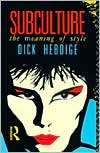Subculture: The Meaning of Style (New Accents Series)
Search in google:
'Hebdige's Subculture: The Meaning of Style is so important: complex and remarkably lucid, it's the first book dealing with punk to offer intellectual content. Hebdige [...] is concerned with the UK's postwar, music-centred, white working-class subcultures, from teddy boys to mods and rockers to skinheads and punks.' - Rolling StoneWith enviable precision and wit Hebdige has addressed himself to a complex topic - the meanings behind the fashionable exteriors of working-class youth subcultures - approaching them with a sophisticated theoretical apparatus that combines semiotics, the sociology of devience and Marxism and come up with a very stimulating short book - Time Out This book is an attempt to subject the various youth-protest movements of Britain in the last 15 years to the sort of Marxist, structuralist, semiotic analytical techniques propagated by, above all, Roland Barthes. The book is recommended whole-heartedly to anyone who would like fresh ideas about some of the most stimulating music of the rock era - The New York Times
Introduction: Subculture and StyleONE From Culture to Hegemony PART ONE: SOME CASE STUDIES TWO Holiday in the Sun: Mister Rotten Makes the Grade Boredom in Babylon THREE Back to Africa The Rastafarian Solution Reggae and Rastafarianism Exodus: A Double Crossing FOUR Hipsters, Beats and Teddy Boys Home-grown Cool: The Style of the Mods White Skins, Black Masks Glam and Glitter Rock: Albino Camp and Other Diversions Bleached Roots: Punks and White "Ethnicity" PART TWO: A READING FIVE The Function of Subculture Specificity: Two Types of Teddy Boy The Sources of Style The Sources of Style SIX Subculture: The Unnatural Break Two Forms of Incorporation SEVEN Style as Intentional Communication Style as bricolage Style in Revolt: Revolting Style EIGHT Style as Homology Style as Signifying Practice NINE O.K., it's Culture, but is it Art? Conclusion








